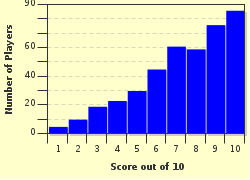Quiz Answer Key and Fun Facts
1. Gravity is a force that pulls us towards the ground on Earth. It makes things fall and plummet without the help of any other forces. In which of the following nursery rhymes is gravity not the cause of a fall?
2. "Harmonics" are waves that are created in a string or any other material that can vibrate only at certain frequencies. If we can control these, we can make the frequencies produced give us musical tones. In which of these nursery rhymes are the musicians using harmonics?
3. An inseparable part of physics is the study of the sky and the heavens. This is known as cosmology, and is featured in which of the following nursery rhymes?
4. Tension is a force that's created when you pull on one end of a rope or string. If one end gets pulled, the other end pulls whatever it is tied to. In which of these nursery rhymes does the main character have to create tension in a rope? (Hint: I hope the name rings a bell with you)
5. "Work" is an important concept in physics that lets you know how much energy you put into making something happen. Whether you're lifting a box or a horse is pulling a cart, it takes work! Which of these rhymes involves work (though not too much)?
6. Centrifugal force happens when we move in a circle or any curving motion. It's the feeling that you get thrown against the side of a car when it is turning. In which of these nursery rhymes would you not feel centrifugal force?
7. In physics, "kilo" is a prefix that means "one thousand". For example, a kilometer is one thousand meters, or a kilogram is one thousand grams. In which of the following nursery rhymes did the fearless leader have not one, but ten 'kilo-men'?
8. Combustion is a process which gives off heat and light. An example, your fire in the fireplace burns and gives off heat to warm the house and orange light from the flames. In which of these rhymes does our character avoid the combustion to not get singed?
9. If you shoot a rocket into space to reach the moon, you had better make it go faster than the Earth's escape velocity. "Escape velocity" is a speed that if you're slower than that, you can't leave Earth's gravity and reach other moons, planets and stars.
In which nursery rhyme does a character need to be faster than Earth's escape velocity?
10. One of the more difficult branches of physics is cloud physics. It tries to predict the formation of condensation and the necessary conditions for precipitation - rain, hail, sleet, or snow.
In which of the following nursery rhymes was precipitation caused?
Source: Author
LeoDaVinci
This quiz was reviewed by FunTrivia editor
agony before going online.
Any errors found in FunTrivia content are routinely corrected through our feedback system.

